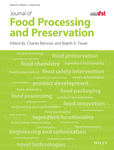The effects of static, oscillating, and oscillating with dwell time retort motions on the rate of heat penetration of a food simulant processed in a pouch
Abstract
The objective of this work was to study the effect of three different retort motions on the rate of heat penetration in pouches. Pouches were processed in a water spray batch retort system using static, oscillating continuously at a speed of 10.5 rotations per minute (RPM) with an angle of 15 degrees, and oscillating at 10.5 rpm at a 15 degree angle with a 15-s hold. There was no difference in the rate of between static and oscillating processes (p > .05). There was a difference in the between static and oscillating with a hold processes (p < .05). At a 90% confidence interval, there was also a difference between the rate of heat penetration between the oscillating and oscillating with a hold processes (p > .05, p = .056). The location of the pouches on the retort rack did not influence the rate of heat penetration within the three methods or between the three methods (p > .05).
Practical applications
Despite novel technological developments for creating sterile shelf stable products, thermal processing is still the most reliable method. Creating innovation within thermal processing by using different methods of motion to create faster heating profiles can improve the quality of products. This research can be used for optimizing retort processes for food products in pouches. Processing with motion has been seen to reduce the processing time which can increase nutrient retention, reduce thermal abuse, and ultimately save money and increase production. Retort food manufacturers can use oscillating and hold motion to make higher quality products in less time than static motion.




